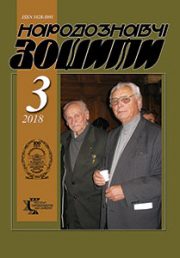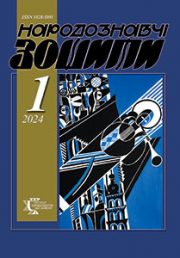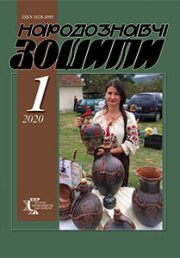The Ethnology Notebooks. 2020. № 3 (153), 685—694
UDK [7:338.45]:[904:339.5](5:477)”11/13″
DOI https://doi.org/10.15407/nz2020.03.685
CULTURAL INFLUENCE OF THE EAST IN INTERNATIONAL RELLATIONS SYSTEM OF GALICIA-VOLHYNIA STATE
CHUYKO Oleh
ORCID ID: https://orcid.org/0000-0003-3713-5593
Associate Professor, Candidat of Arts (Doctor of Arts Studies)
Public Higher Education Institution
Vasyl Stefanyk Precarpathian National University,
Shevchenko Str., 57, Ivano-Frankivsk,
Ivano-Frankivsk region, 76000
Contacts: e-mail: art.trivium@gmail.com
Abstract. Numerous works of decorative and applied arts from the territory of the Galicia-Volhynia state testify to the significant role of Eastern cultural influences on the artistic processes of Southwestern Rus. Although national researchers have addressed the topic of Culture of Ukraine and the East for a long time, the medievalists have mainly based their research on materials from Kyivan and Vladimir-Suzdal Rus. The scientific researches based on artifacts of princely era of Galician lands, though not uncommon, deal with some art forms, sometimes without considering general cultural and historical situation. Most of them have been published by archaeologists. However, it is the archaeological heritage of Ancient Halych that proves the usage in its territory of things of Iranian, Caucasian, Central Asian and Syrian-Palestinian origin, which constituted an essential part of the import of Galician Rus and testify to its active and far-flung network of trade contacts.
The Aim of this paper is to reveal influences of figurative, stylistic, iconographic and technological system of Oriental art on the artistic culture and life of Southwestern Rus from the perspective of international contacts, in particular trade relations of the Galicia-Volhynia state.
Research Methodology. In an attempt to research the above mentioned topic, we use systematic approach and principle of historicism, which have enabled us to consider the culture of the Galicia-Volhynia land as a complex, multidimensional system within the framework of a certain historical period, depending on local social and cultural factors. We have used art-study methods of figurative, stylistic and iconographic analysis.
Findings. In this paper we discuss some aspects of cultural exchange between the Galicia-Volhynia state and Asian countries. We explore a wide range of artifacts (weapons, numismatic objects, household items, jewelry).
Novelty. Based on systematization of sources, the paper reconstructs an integral picture of cultural and economic contacts between Galician Rus and Eastern countries, mainly in the field of trade and artistic handicraft. We analyze artifacts of eastern origin discovered on the lands of Southwestern Rus as an important component of developing material culture in the region, as well as aesthetic demands of its population. We study a significant collection of decorative oriental ceramics, which are abundant in cultural layers of Galicia-Volhynia cities.
Practical Application of the Research. Conceptual issues of the paper can be used in teaching the Humanities, as teaching aids in training courses on the History of Ukrainian Culture and Regional Ethnography.
Keywords: East, trade, numismatics, goods, import, ceramics, decor, Oriental Studies, nomads.
Received 4.05.2020
REFERENCES
Vagner, G. (1976). Background of zoomorphic ornaments in ancient Ruthenian art. Scythian-Siberian zoomorphic ornaments in the art of Eurasian peoples. Moscow [in Russian].
Darkevich, V.P. (1976). Artful metal of the East of the 12th—13th centuries. Works of eastern toreutics in the European part of the USSR and Trans-Urals. Moscow: Nauka [in Russian].
Korzukhina, G.F., & Peskova, A.A. (2003). Ancient Ruthenian encolpions. Pectoral reliquary crosses of the 11th—13th centuries. St. Petersburg: Petersburgskoye vostokovedenye [in Russian].
Lysenko, P.F. (1985). Berestye. Minsk: Nauka i teknika [in Russian].
Mikhalchenko, S.E. (1974). Spherocones of the Volga region. Brief Communications of the Institute of Archeology of the USSR Academy of Sciences (Pp. 46—50). Moscow: Nauka [in Russian].
Fersman, A.E. (1974). Tales of gems. Moscow: Nauka [in Russian].
Zhdan, M.B (1967). Revising dependence of Galicia-Volhynia Rus on the Golden Horde. Ukrainian Historical Journal, 1—2, 34—71 [in Ukrainian].
Zhyshkovych, V. (1995). Oriental sources in the plastic arts of Ukraine-Rus (10th—13th centuries). Ethnographical Fascicles, 3, 151—154 [in Ukrainian].
Zabashta, R. (1995). Pagan sculpture, plastic arts of early medieval Slavs and nomadic Turks (revising the interconnection issue). Ethnographical Fascicles, 3, 145—150 [in Ukrainian].
Kopytko, A. (2000). Items of Middle Eastern origin on Galician and Volhynian lands (10th—13th centuries). Archaeological Research at Lviv University, 4, 166—172 [in Ukrainian].
Koshovyi, O. (1997). Galician ceramic tiles of the 12th—13th centuries. (Genesis, iconography, semantics): Extended abstract of Cand. Sci. (Art Criticism) dissertation. Lviv [in Ukrainian].
Lelekova, L.A. (1978). The Art of Ancient Rus and the East. Moscow: Sovetskiy Khudozhnik [in Russian].
Terskyi, S. (2010). Princely city of Volodymyr. Lviv: Publishing House of Lviv Polytechnic National University [in Ukrainian].
Petehyrych, V.M. (2011). Two rare finds of princely times from Sokal in Lviv region. Scientific Studies (Issue 4, pp. 254—267). Museum of Local History in Vynnyky. Lviv [in Ukrainian].
Zabashta, R. (1995). Pagan sculpture, plastic arts of early medieval Slavs and nomadic Turks (revising the interconnection issue). Ethnographical Fascicles, 3, 145—150 [in Ukrainian].
Antonovich, V.B. (1901). Archaeological map of the Volyn province. Proceedings of the XI Archaeological Congress in Kyiv (Vol. I, pp. 36—133) [in Russian].
Terskyi, S. (2010). Princely city of Volodymyr. Lviv: Publishing House of Lviv Polytechnic National University [in Ukrainian].
Kirpichnikov, A.N. (1973). Equipment of an equestrian and a riding horse in Rus of the 9th—13th centuries. Leningrad: Nauka [in Russian].
Aulikh, V. (1987). Blacksmiths of gold, silver and copper of ancient Halych. Zhovten, 10, 96—100 [in Ukrainian].
Stanchak, Ya. (1993). Collection of encolpions from the Lviv Historical Museum. Transactions of the Lviv Historical Museum (Vol. 1, pp. 87—95). Lviv [in Ukrainian].
Fedorov-Davydov, G.A. (1976). The art of nomads and the Golden Horde. Essays on the culture and art of the peoples of the Eurasian steppes and the Golden Horde cities. Moscow: Iskusstvo [in Russian].
Sveshnikov, I.K. (1990). Zvenyhorod. Archeology of Precarpathia, Volhynia and Transcarpathia (Early Slavic and Ancient Ruthenian periods). Kyiv: Naukova Dumka [in Russian].
Kropotkin, V.V. (1971). New finds of Sassanian and Kufic coins in Eastern Europe. In Numismatics and epigraphies, IX, 76—97 [in Russian].
Shust, R. (2007). Numismatics. History of monetary circulation and monetary business in Ukraine. Kyiv: Znannia [in Ukrainian].
Korzukhina, G.F. (1954). Russian Treasures. Moscow; Leningrad: Izdatelstvo AN SSSR [in Russian].
Yagodynska, M. (1999). Ancient Ruthenian housing with ground floor from Terebovlya. Ukrainian Science: Past, Present, Future. Yearly periodical (Pp. 96—101). Ternopil: Economichna dumka [in Ukrainian].
Darkevich, V.P. (1976). Artful metal of the East of the 12th—13th centuries. Works of eastern toreutics in the European part of the USSR and Trans-Urals. Moscow: Nauka [in Russian].
Rauhut, L. (1960). Early medieval archeological material from Ukraine in the National Museum of Archaeology in Warsaw. Early medieval materials, 5, 231—259 [in Polish].
Terskyi, S. (2006). Luchesk of the 10th—15th centuries. Lviv: Publishing House of Lviv Polytechnic National University [in Ukrainian].
Pashuto, V.T. (1968). Foreign policy of Ancient Rus. Moscow: Nauka [in Russian].
Mikhalchenko, S.E. (1974). Spherocones of the Volga region. Brief Communications of the Institute of Archeology of the USSR Academy of Sciences (Pp. 46—50). Moscow: Nauka [in Russian].
Parshina, E.A. (1974). Medieval ceramics of South Taurica (following excavations and explorations in 1969). In Feudal Taurica: Crimean history and archeology records (Pp. 56—94). Kyiv: Naukova Dumka [in Russian].
Yakobson, A.L. (1979). Pottery and ceramic production of medieval Taurica. Leningrad: Nauka [in Russian].
Parshina, E.A. (1974). Medieval ceramics of South Taurica (following excavations and explorations in 1969). In Feudal Taurica: Crimean history and archeology records (Pp. 56—94). Kyiv: Naukova Dumka [in Russian].
Tomenchuk, B.P. (1985). Rescue excavations in Precarpathia. Archaeological discoveries of 1985. Moscow: Nauka [in Russian].
Terskyi, S. (1998). Old Market in Lviv (following archaeological studies). In Halych and Galician land in the state-making processes of Ukraine. Digest. Halych: Plai [in Ukrainian].
Terskyi, S.V. (1995). Volhynia in terms of international relations of Kyivan Rus (10th—14th centuries). Transactions of the Lviv Historical Museum (Vol. 1, pp. 73—88). Lviv [in Ukrainian].
Terskyi, S. (2002). Archeology of the times of the Galicia-Volhynia state. Findings of the Volyn Archaeological Expedition undertaken by the Lviv Historical Museum over 15 years (1986—2000). Exhibition catalog. Lviv [in Ukrainian].
Zelenko, S. (1999). Findings of studies of the underwater archaeological expedition undertaken by T. Shevchenko Kyiv University on the Black Sea in 1997—1999. Vita Antiqua, 2, 223—234 [in Russian].
Pryshchepa, B.A., & Nikolchenko, Yu.M. (1996). Dorogobuzh, mentioned in the annals, in the period of Kyivan Rus. Revising the history of the population of Western Volhynia in the 10th—13th centuries. Rivne: State Editorial and Publishing Company [in Ukrainian].
Kirpichnikov, A.N. (1973). Equipment of an equestrian and a riding horse in Rus of the 9th—13th centuries. Leningrad: Nauka [in Russian].
Pyvovarov, S. (2008). Stone icons in ancient Ruthenian antiquities of Bukovina In S. Pyvovarov. Ethnoculture in the Context of World History (Proceedings of the XI International Berezovsky Readings Seminar in Chernivtsi on March 20, 2004) (Pp. 98—108). Chernivtsi [in Ukrainian].
Ratych, O.O. (1976). Population of Precarpathia and Volhynia in the era of Kyivan Rus in the period of feudal disunity. In Population of Precarpathia and Volhynia during the times of decay of the primitive community and in ancient Ruthenian times (Pp. 132—206). Kyiv: Naukova dumka [in Ukrainian].
Zelenska, V.M., & Kalashnik, Yu.P. (1992). Chersonesus 20th Quarter in the 13th century (According to Archeology and Artefacts). Archeology, 3, 70—78 [in Ukrainian].
Korzukhina, G.F., & Peskova, A.A. (2003). Ancient Ruthenian encolpions. Pectoral reliquary crosses of the 11th—13th centuries. St. Petersburg: Petersburgskoye vostokovedenye [in Russian].
Lelekova, L.A. (1978). The Art of Ancient Rus and the East. Moscow: Sovetskiy Khudozhnik [in Russian].
Korzukhina, G.F., & Peskova, A.A. (2003). Ancient Ruthenian encolpions. Pectoral reliquary crosses of the 11th—13th centuries. St. Petersburg: Petersburgskoye vostokovedenye [in Russian].
Korzukhina, G.F., & Peskova, A.A. (2003). Ancient Ruthenian encolpions. Pectoral reliquary crosses of the 11th—13th centuries. St. Petersburg: Petersburgskoye vostokovedenye [in Russian].
Pyvovarov, S. (2005). The Chornivka settlement of the early 13th century (new findings). A window into European science (Proceedings of the II International Scientific Kaindl Readings Seminar in Chernivtsi on May 28—29, 2005) (Pp. 195—201). Chernivtsi [in Ukrainian].
Korzukhina, G.F., & Peskova, A.A. (2003). Ancient Ruthenian encolpions. Pectoral reliquary crosses of the 11th—13th centuries. St. Petersburg: Petersburgskoye vostokovedenye [in Russian].
Pyvovarov, S.V. (2001). Christian Antiquities between the Upper Prut and Middle Dniester rivers. Chernivtsi: Zelena Bukovyna [in Ukrainian].
Pyvovarov, S. (2005). The Chornivka settlement of the early 13th century (new findings). A window into European science (Proceedings of the II International Scientific Kaindl Readings Seminar in Chernivtsi on May 28—29, 2005) (Pp. 195—201). Chernivtsi [in Ukrainian].
Fekhner, M.V. (1961). Some archeological data on the history of economic ties between Rus and the East until mid — 13th century. In International relations of Russia until the 17th century (Pp. 46—54). Moscow [in Russian].
Kharytonova, O. (2006). Krylos treasure. Transactions of the Ivano-Frankivsk Local History Museum (Vol. 1, pp. 73—88). Ivano-Frankivsk [in Ukrainian].
Rogatko, J. (1990). Monuments from the collection of Piotr Kania from Grуdek nad Bugiem, Zamojskie voivodeship. Lublin archaeological materials, 3, 183—200) [in Polish].
Medvedev, A.F. (1963). Middle East and Golden Horde glazed ceramics from the excavations of Novgorod. Reports and Studies on Archeology of the USSR, 117 (Vol. 3, pp. 269—283). Moscow; Leningrad: Nauka [in Russian].
Gurevich, F.D. (1981). Ancient Navahrudak (the settlement and outer city). Leningrad: Science [in Russian].
Ratych, O.O. (1976). Population of Precarpathia and Volhynia in the era of Kyivan Rus in the period of feudal disunity. In Population of Precarpathia and Volhynia during the times of decay of the primitive community and in ancient Ruthenian times (Pp. 132—206). Kyiv: Naukova dumka [in Ukrainian].
Mirolyubov, M.A. (Ed.). (1983). Ancient Ruthenian city of Iziaslav: exhibition catalog (from the collection of the Hermitage Museum). Leningrad: G.E. [in Russian].






